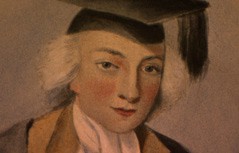Victoria here, writing about my annual trip to Washington, D. C. Whenever I can, I visit one or more of the great museums of the Smithsonian Institution, and I always think about the way it got started by a posthumous gift from James Smithson (1765-1829) “to found, at Washington, under the name of the Smithsonian Institution, an Establishment for the increase and diffusion of knowledge.” In typical American political fashion, there was considerable debate about how the gift would be used, but by 1846, President James Polk signed the bill that created the SI.
The Red Castle on the Mall, Independence Avenue facade
Quoting from the SI’s brochures: James Smithson “was born James Lewis Macie in Paris, France, in 1765. His mother was the widow Elizabeth Hungerford Keate Macie of Bath, England, a descendant of Henry VII. His father, Hugh Smithson, the Duke of Northumberland, was actually married to his mother’s cousin. After his mother’s death in 1800, he officially changed his name to Smithson …graduated from Pembroke College, Oxford, in 1786, the same year he became a naturalized British citizen…he was the youngest to be admitted as a Fellow of the Royal Society…in 1802, he identified a specific zinc ore that was posthumously renamed smithsonite in his honor…”
Painting of James Smithson in the Red Castle
It is tempting to speculate on Why Smithson left his fortune to the US, a place he never visited. Perhaps he was offended by the way in which the English aristocracy treated him as the illegitimate son of a Duke. Perhaps he admired the experiement in government across the Atlantic. However he made the decision, the result cannot be disputed: a great institution which honors his name.
a youthful Smithson, by James Roberts, 1786
A chemist and geologist, Smithson died in Genoa, Italy, in 1829 and was buried there. In 1903, Alexander Graham Bell (a Regent of the SI) and his wife bought Smithson’s remains to Washington where he is now at rest.
Memorial to James Smithson in the Red Castle
The Red Castle, designed by architect James Renwick Jr. in the Medieval Revival style, was the first of the SI Buildings and housed the complete collection and operations for many years. It was remodeled and enlarged after a fire in 1865. Today, the building houses the information center, a few of the original displays, and the ubiquitous gift shop. Below are a few views I took of the Red Castle.
from the Mall
reflection of the Washington Monument in the window
The Great Hall
Peacock in the Commons (stuffed)
gift shop
The Smithsonian has grown to a gigantic size today, with parts of the SI located in many places besides Washington. But it remains in the popular mind, a collection of large and fascinating museums along the Mall between the Washington Monument and the Capitol. Here are a few you might have visited.
Museum of American H
istory
Freer Gallery of Art
Museum of Natural History
Museum of African Art
Air and Space Museum
Museum of the American Indian
Tipis on the lawn of the American Indian Museum, with the Capitol nearby
This is just the beginning of the Smithsonian journey — in which you can participate by internet, tours, special aps, the magazine and video productions. Just start by clicking
here.
What would James Smithson think of the results of his gift of about half a million dollars? Since we can only guess why he gave the money in the first place, he could have no way of expecting that his gift would start one of the world’s greatest educational and research institutions. Thank you, Mr. Smithson!
Soon I will write more about my visit to the National Gallery, a neighbor to the Smithsonian Museums but a separate entity.
